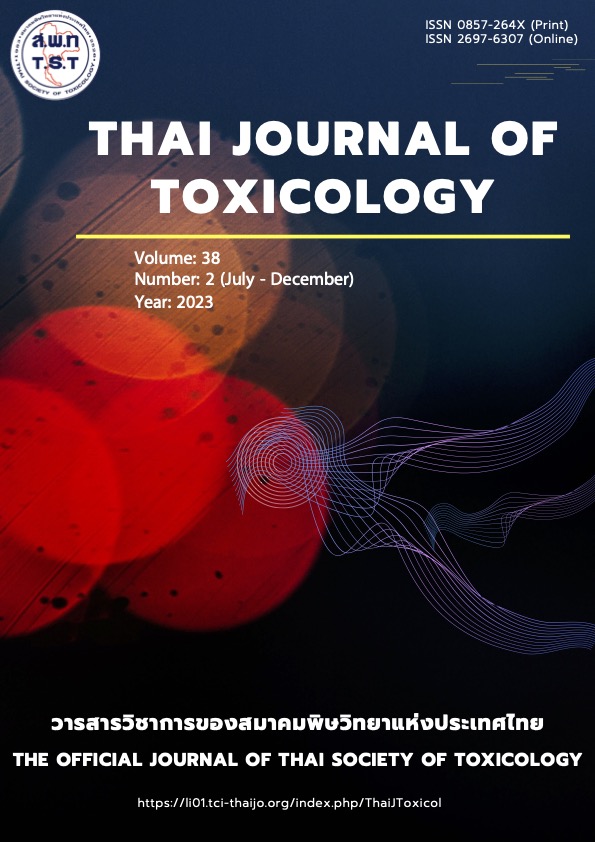Implementation of Developed Quality Control Material for Performance Checkup of Alcohol Breath Analyzer in Bangkok Metropolitan Police Station
Main Article Content
Abstract
The Land Traffic Act has defined the penalty for driving under the influence of alcohol when a blood alcohol content is higher than 50 mg/dL, which is routinely monitored by police officers using electrochemical analyzer to measure the breath alcohol concentration. Presently, calibration and maintenance of analyzers are common procedures on the schedule (every 6 months). However, there is a lack of definite guidelines and continuous control due to the high cost of materials. In addition, the measurement results may be inaccurate due to the lifetime of materials or improper storage of analyzers. This study aimed to test the performance of control materials that have been locally developed with alcohol breath analyzers at Bangkok Metropolitan Police Station. A cross-sectional analytical study was performed in 77 analyzers 2 models. Control material concentrations at 28, 67, and 134 mg/dL were tested by a wet bath simulator. The results showed that 55 out of 77 alcohol breath analyzers which were calibrated within 4 months had %Total error (TE) of 16.95%, 11.43%, and 8.60% at 28, 67, and 134 mg/dL, respectively, which met 20% CLIA’s TE criteria. However, analyzers that have their last calibration more than 4 months had %TE above the accepted criteria. In conclusion, the developed control material revealed valuable data-related analyzer calibration guidelines. Analyzers should schedule the calibration every 4 months (3 times/year) to achieve the accuracy and reliability of the test results.
Article Details
References
WHO. Global status report on alcohol and health 2018: World Health Organization, 2019. Available at https://www.who.int/publications/i/item/978924 1565639, accessed on Feb 23, 2023.
Fell JC, Voas RB. The effectiveness of reducing illegal blood alcohol concentration (BAC) limits for driving: evidence for lowering the limit to 05BAC. J safety Res 2006; 37: 233-43.
Ministry of Transport. Road Accident Report, 2022. Available at https://datagov.mot.go.th/dataset/road-accident/resource/960813aa-f410-4356-bd5a-10f6 3c8e4ce0?inner_span=True.], accessed on Feb 12, 2023.
Thai government gazette. Road Traffic Act, 1979. Available at http://web.krisdika.go.th /data/law/law 2/%A803/%A803-20-9999-update.htm, accessed on Jan 5, 2023.
Thai government gazette. Ministerial Regulations, 2017. Available at https://www.royalthaipolice. go.th/downloads/laws/laws_03.pdf, accessed on Jan 5, 2023.
Jung Y, Kim J, Awofeso O, et al. Smartphone-based colorimetric analysis for detection of saliva alcohol concentration. Appl Opt 2015; 54: 9183-9.
Wang X, Yee S, Carey P. An integrated array of multiple thin-film metal oxide sensors for quantification of individual components in organic vapor mixtures. Sens Actuators B Chem 1993; 13: 458-61.
Pérez-Ponce A, Garrigues S, de La Guardia M. Vapour generation–fourier transform infrared direct determination of ethanol in alcoholic beverages. Analyst 1996; 121: 923-8.
Ozoemena KI, Musa S, Modise R, et al. Fuel cell-based breath-alcohol sensors: Innovation-hungry old electrochemistry. Curr Opin Electrochem 2018; 10: 82-7.
Bunsoong J, Bunsoong T. Preparation of Ethyl Alcohol Standard Solution for Breath Analyzer Calibration. Bull Dept Med Sci 2020; 62: 96-105.
International Organization of Legal. OIML R 126:2012 (E). Evidential breath analyzers, 2012. Available at https://www.oiml.org/en /files/pdf_r/ r126-e12.pdf, accessed on May 3, 2023.
Anghel MA. Quality assurance in breath-alcohol analysis. UPB Sci Bull 2006; 68: 61-70.


